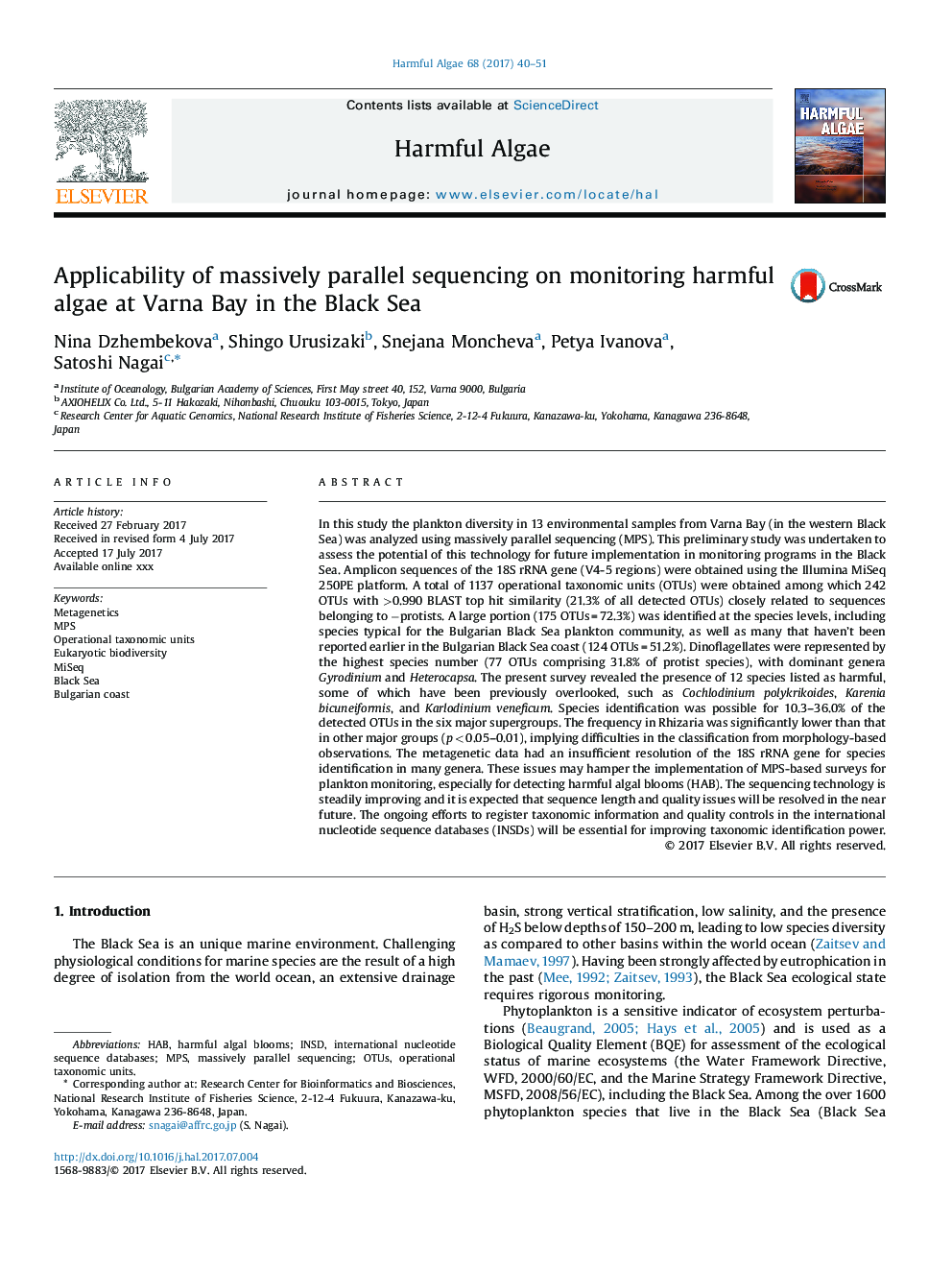| کد مقاله | کد نشریه | سال انتشار | مقاله انگلیسی | نسخه تمام متن |
|---|---|---|---|---|
| 5765753 | 1626904 | 2017 | 12 صفحه PDF | دانلود رایگان |
عنوان انگلیسی مقاله ISI
Applicability of massively parallel sequencing on monitoring harmful algae at Varna Bay in the Black Sea
ترجمه فارسی عنوان
کاربرد تعیین توالی عمیق موثر در نظارت بر جلبکهای مضر در خیابان وارنا در دریای سیاه
دانلود مقاله + سفارش ترجمه
دانلود مقاله ISI انگلیسی
رایگان برای ایرانیان
کلمات کلیدی
موضوعات مرتبط
علوم زیستی و بیوفناوری
علوم کشاورزی و بیولوژیک
علوم آبزیان
چکیده انگلیسی
In this study the plankton diversity in 13 environmental samples from Varna Bay (in the western Black Sea) was analyzed using massively parallel sequencing (MPS). This preliminary study was undertaken to assess the potential of this technology for future implementation in monitoring programs in the Black Sea. Amplicon sequences of the 18S rRNA gene (V4-5 regions) were obtained using the Illumina MiSeq 250PE platform. A total of 1137 operational taxonomic units (OTUs) were obtained among which 242 OTUs with >0.990 BLAST top hit similarity (21.3% of all detected OTUs) closely related to sequences belonging to âprotists. A large portion (175 OTUs = 72.3%) was identified at the species levels, including species typical for the Bulgarian Black Sea plankton community, as well as many that haven't been reported earlier in the Bulgarian Black Sea coast (124 OTUs = 51.2%). Dinoflagellates were represented by the highest species number (77 OTUs comprising 31.8% of protist species), with dominant genera Gyrodinium and Heterocapsa. The present survey revealed the presence of 12 species listed as harmful, some of which have been previously overlooked, such as Cochlodinium polykrikoides, Karenia bicuneiformis, and Karlodinium veneficum. Species identification was possible for 10.3-36.0% of the detected OTUs in the six major supergroups. The frequency in Rhizaria was significantly lower than that in other major groups (p < 0.05-0.01), implying difficulties in the classification from morphology-based observations. The metagenetic data had an insufficient resolution of the 18S rRNA gene for species identification in many genera. These issues may hamper the implementation of MPS-based surveys for plankton monitoring, especially for detecting harmful algal blooms (HAB). The sequencing technology is steadily improving and it is expected that sequence length and quality issues will be resolved in the near future. The ongoing efforts to register taxonomic information and quality controls in the international nucleotide sequence databases (INSDs) will be essential for improving taxonomic identification power.
ناشر
Database: Elsevier - ScienceDirect (ساینس دایرکت)
Journal: Harmful Algae - Volume 68, September 2017, Pages 40-51
Journal: Harmful Algae - Volume 68, September 2017, Pages 40-51
نویسندگان
Nina Dzhembekova, Shingo Urusizaki, Snejana Moncheva, Petya Ivanova, Satoshi Nagai,
